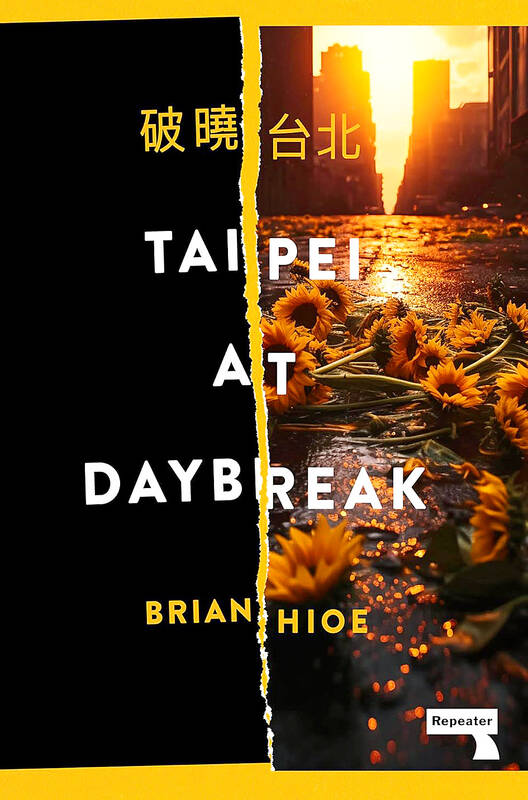This is a strange book. I wanted to like it: I know the author, have attended several excellent talks that he has hosted at his cafe and event space Daybreak, and respect his activism and contribution to communicating Taiwan to the world in a way that was lacking until he cofounded New Bloom magazine in 2014.
Through this vehicle, Brian Hioe has tirelessly advocated for the rights of minorities and the disenfranchised, called out injustices and inequalities, past and present, and pushed back against democratic backsliding.
In articles for The Diplomat, he has introduced Taiwan’s politics and society to a wider audience, making it palatable for the uninitiated, steering clear of the usual cliches that define the country through its relations with China, and affording it an agency invariably absent from international reports.

At public events, he demonstrates erudition, eloquence and a keen intellect. I’ve not left any of the Daybreak discussions without having learned something — usually quite a lot (including a load of new conceptual and theoretical terminology!).
Yet, the passion the drives this work is largely absent from these pages. The narrator, QQ, who Hioe has described as a fictionalized version of himself, based on his experiences as an activist during the 2011 Occupy Wall Street movement in New York and the 2014 Sunflower movement, has almost no redeeming attributes.
On the back cover and inside pages, a quote from Shawna Yang Ryan, author of the White Terror-focused novel Green Island, compares Hioe’s novel stylistically to the works of Camus and Dostoevsky. While this is quite a reach, there are perhaps tenuous similarities — the sparse prose and depiction of a tortured soul searching for meaning through action.
Yet, unlike Camus’ Meursault, whose sensuality and casual rejection of social norms has visceral appeal, or Dostoevsky’s Raskolnikov, whose moral conundrum and theorizing about the “extraordinary man,” fascinates, there is little about QQ for a reader to latch on to. He is a not even an antihero.
ACTION, APATHY AND ALIENATION
As creeping nihilism takes hold, QQ perhaps better recalls the superfluous men of Russian literature — Pechorin, the fatalistic hero of Lermontov’s A Hero of Our Time or, at times, as QQ festers in his “windowless box,” where “the outside world had ceased to exist or might never have existed,” — the listless title character Oblamov in Goncharov’s classic study of inaction.
Of course, unlike the affable Oblamov, QQ is not completely paralyzed by apathy — he is, or sees himself as, very much a man of action. It is through his participation in social movements, protests and increasingly the prospect of violence that he comes to define himself.
At a recent discussion of his book at Daybreak (the event space), Hioe noted that social movements often attract participants with emotional and mental health issues.
“You encounter a lot of people that are quite alienated,” he said.
Still, for all the emphasis on the existentialist credo of being as doing, the scenes depicting concrete action — the March 18, 2014 assault on the Legislative Yuan and a week later the storming of the Executive Yuan during the Sunflower protests, and the occupation of the Ministry of Education grounds in July 2015 — are distinctly underwhelming.
A NEW DAWN
Upon receiving news of the initial “318” occupation of the legislature, QQ is strangely “dismissive,” and “cynical,” suspecting the protesters will quickly be dislodged. The news is insufficiently important to interrupt dinner with a friend. Then, having “got antsy,” the narrator declares himself “never one to pass up a chance for action,” and “decide[s] to take a gamble.”
It all comes across as contradictory and half-hearted. Outside the legislature, he admits that he “hung around at the back” for fear of arrest, while others “grew more and more brazen.” Instead of joining the vanguard, QQ lingers sheepishly on the periphery, checking social media for updates from those inside the building. Eventually, propping his head against a vehicle in a carpark, he begins to snooze.
It’s true, the image of sunflowers being clasped and waved by the protesters at dawn, as QQ drifts in and out of slumber, is an appealing symbol of hope. Hioe has attributed the name of the Daybreak Project — an oral history archive of the movement, which can be found at the New Bloom Web site, his cafe/event space and the book’s title to this awakening and the promise of change brought by Taiwan’s young activists.
VIOLENT FANTASIESM
In this image, we have something of a counterpoint to the protagonist’s misanthropy and his trajectory toward self-destruction. Punctuated by cryptic and increasingly unhinged interpolations from a one-way conversation with an unknown individual dubbed “V,” the protagonist’s reflections hint at dissociation.
While QQ is more hands-on during the “324” attempt to occupy the Executive Yuan, joining the throng to push back the riot-shielded police, he still ends up “ejected from the center of the charge” where he “assumed a look of not really understanding what I was doing,” seemingly to protect himself from the police batons.
Later, he joins a group of people lying on the ground to prevent the police from cutting through the encirclement of protesters, alongside an activist comrade who sobs at the brutality of it all, before things gradually fizzle out.
At the 2015 education ministry protest, sparked by the then-Chinese Nationalist Party (KMT) government’s proposed changes to the high school curriculum and the suicide of student activist Lin Kuan-hua (林冠華), QQ approaches the stage where a local mobster (the Grey [sic] Wolf in Hioe’s telling), is haranguing the students with anti-Japanese slogans.
Although the gangster — a depiction of real-life organized crime figure and fringe pro-China politician Chang An-lo (張安樂), who is nicknamed the White Wolf — is surrounded by his goons, QQ fantasizes about dragging him from the stage and breaking his neck.
“I didn’t have this black belt for nothing, not that it had ever been useful,” he says — again seeming to contradict himself.
MISSED OPPORTUNITY
Like many of his thoughts, statements and actions, this throwaway revelation of pugilistic prowess, of which there is no previous indication, comes across as empty bravado, especially when, predictably, he just slinks off into the crowd.
A sudden reference to bouts of booze-fueled aggression after consuming “the entirety of a small bottle of whiskey” is similarly unconvincing, as are attempts to communicate the danger he and his comrades face during the various incidents.
Even the one scene where he actually does something dangerous and genuinely violent — smacking a friend in the gob — seems tacked on and implausible.
Perhaps this is deliberate: This “Asian American coming of age novel,” as the back cover blurb has it, aims to show a young, conflicted soul desperate to prove himself and be a part of something. Expressing his envy of a fellow activist, he admits, “I had never been willing to take such risks for things I believed in.”
Still, it all makes for a frustratingly hollow reading experience and not because of the “emptiness,” that QQ refers to when addressing V.
Here and there, glimmers of something more profound emerge: ruminations on Asian American identity — QQ’s description of himself as the gap in the text between the words “Taiwanese” and “American” providing a memorable metaphor.
But with such an unsympathetic lead and supporting characters flitting in and out, with rarely enough to them to make you care, this feels like a missed opportunity to render a pivotal moment in contemporary Taiwanese history through a literary medium.

Dec. 8 to Dec. 14 Chang-Lee Te-ho (張李德和) had her father’s words etched into stone as her personal motto: “Even as a woman, you should master at least one art.” She went on to excel in seven — classical poetry, lyrical poetry, calligraphy, painting, music, chess and embroidery — and was also a respected educator, charity organizer and provincial assemblywoman. Among her many monikers was “Poetry Mother” (詩媽). While her father Lee Chao-yuan’s (李昭元) phrasing reflected the social norms of the 1890s, it was relatively progressive for the time. He personally taught Chang-Lee the Chinese classics until she entered public

Last week writer Wei Lingling (魏玲靈) unloaded a remarkably conventional pro-China column in the Wall Street Journal (“From Bush’s Rebuke to Trump’s Whisper: Navigating a Geopolitical Flashpoint,” Dec 2, 2025). Wei alleged that in a phone call, US President Donald Trump advised Japanese Prime Minister Sanae Takaichi not to provoke the People’s Republic of China (PRC) over Taiwan. Wei’s claim was categorically denied by Japanese government sources. Trump’s call to Takaichi, Wei said, was just like the moment in 2003 when former US president George Bush stood next to former Chinese premier Wen Jia-bao (溫家寶) and criticized former president Chen

Politics throughout most of the world are viewed through a left/right lens. People from outside Taiwan regularly try to understand politics here through that lens, especially those with strong personal identifications with the left or right in their home countries. It is not helpful. It both misleads and distracts. Taiwan’s politics needs to be understood on its own terms. RISE OF THE DEVELOPMENTAL STATE Arguably, both of the main parties originally leaned left-wing. The Chinese Nationalist Party (KMT) brought together radicals, dissidents and revolutionaries devoted to overthrowing their foreign Manchurian Qing overlords to establish a Chinese republic. Their leader, Sun Yat-sen

Late one night in April 2020, towards the start of the COVID lockdowns, Shanley Clemot McLaren was scrolling on her phone when she noticed a Snapchat post by her 16-year-old sister. “She’s basically filming herself from her bed, and she’s like: ‘Guys you shouldn’t be doing this. These fisha accounts are really not OK. Girls, please protect yourselves.’ And I’m like: ‘What is fisha?’ I was 21, but I felt old,” she says. She went into her sister’s bedroom, where her sibling showed her a Snapchat account named “fisha” plus the code of their Paris suburb. Fisha is French slang for